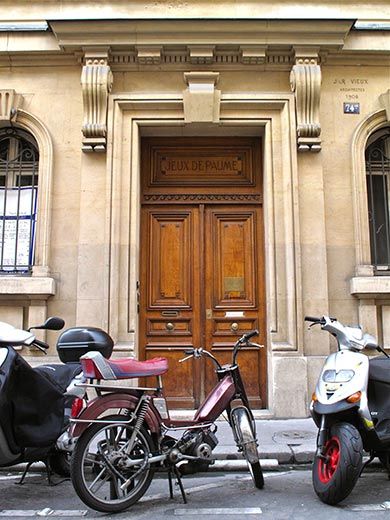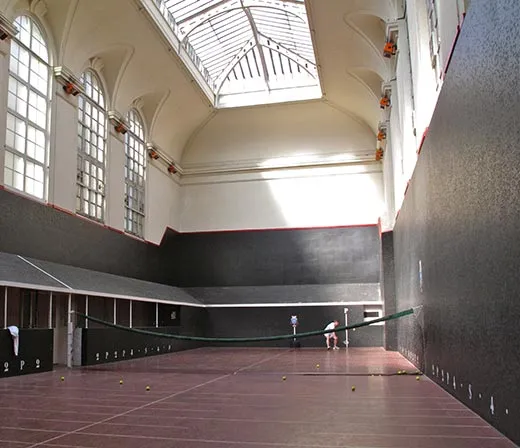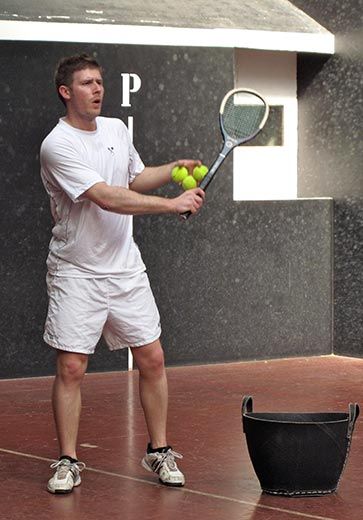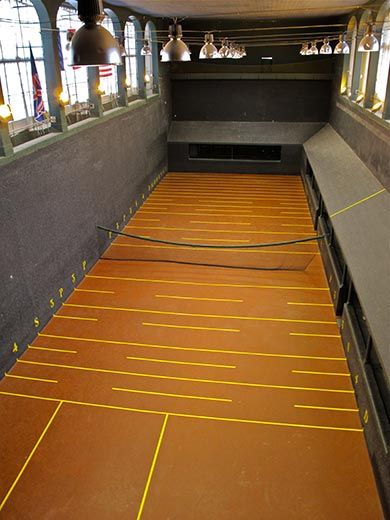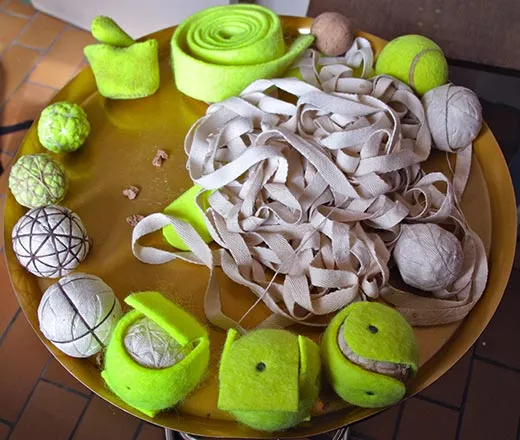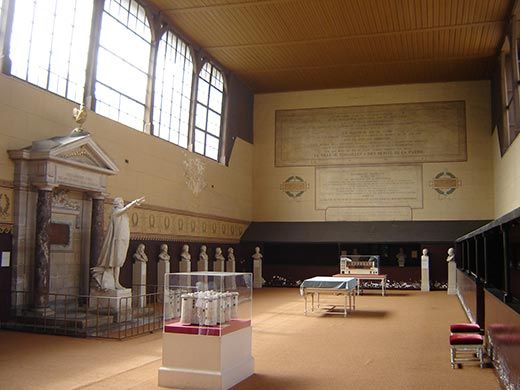Jeu de Paume: Holding Court in Paris
Court tennis, the quirky game of finesse and speed that once dominated France, is now kept alive by a small group of Parisians
/https://tf-cmsv2-smithsonianmag-media.s3.amazonaws.com/filer/court-tennis-jeu-de-paume-631.jpg)
In late April, small trucks filled with orange-red clay lined up near Roland Garros, a large tennis complex in the western outskirts of Paris. Throughout the grounds, workers were moving from court to court, meticulously laying down the clay, a mixture of crushed tile and brick, and chalking lines.
They were preparing the signature look for this month’s French Open. At nearly 120 years old, the Open is a venerable institution with rich history, but its longevity pales in comparison with the game of tennis that’s being played in the city’s 16th arrondissement, about three miles northeast.
At 74 rue Lauriston, a staid Haussmannian building like others in the quarter, a sign made of two metal racquets hangs inconspicuously over the sidewalk. A bronze plaque on the massive wooden front doors reads: Société du Jeu de Paume et Racquets. Inside the club, up two flights of stairs, is what the un-indoctrinated would call a tennis court, but the rubber floor’s reddish hue is really the only similarity to those famed courts at Roland Garros.
Four two-story-high black slate walls, three of which have a sloped roof running along them, surround the rectangular court. There’s a net, but it sags heavily in the middle.
Two white-clad men are on opposite sides of the net, hitting a green felt-covered ball back and forth with wooden racquets. The racquet heads are the size of a small skillet, slightly teardrop-shaped and strung tightly. The ball sounds heavy coming off the racquet and skids constantly. Often the men play shots off one of the lengthwise walls and occasionally aim for large openings in the walls, under which a series of evenly spaced white lines, resembling football yardage markers, extend out across the floor.
They’re playing jeu de paume, a relic of a bygone era in Paris.
Known in English as real tennis or court tennis, jeu de paume, meaning “game of the palm,” is the ancestor of modern lawn tennis, which wasn’t developed until the late 1800s.
Popularized by monks and villagers in southern France during the 11th and 12th centuries (who played with their bare hands, hence the name), paume was one of the country’s favorite pastimes from the 14th to the 17th centuries. At the dawn of the 17th century, there were over 500 courts, from Pau to Chinon.
The sport’s mecca was Paris, where over 7000 citizens — kings, aristocrats and commoners alike — played at nearly 250 courts throughout the city and suburbs.
Today, it’s quite a different story. The bulk of the world’s 8,000 or so players live in England, Australia and the United States. Here in France, there are just three playable courts in the entire country, two of which are in the Paris metro area: Société Sportive, the only one within city limits, and Fontainebleau, the former château of King Henri IV and later Napoleon, situated in a leafy suburb 40 miles to the southeast.
And though a few other remnants of the game’s glorious past still stand in Paris —including two courts built by Napoleon III in the Tuileries, now museums, a hotel on Île Saint-Louis, and the famous salle at Louis XIV’s Versailles where the French Revolution started— jeu de paume has largely faded from the city’s collective memory.
But for the approximately 170 Parisian members of Comité Français de Jeu de Paume, the sport’s national governing body, it’s still the 17th century. Driven by a passion for their unique sport, this small but dedicated group is keeping the game alive.
“What’s interesting for me about paume is that there are so many possibilities for each shot,” explains Gil Kressmann, the former president of Société Sportive. Kressmann, a well-built, graying man in his mid-60s, was introduced to the game as a youngster in Bordeaux. “Each stroke, as a function of your position and that of your opponent, there are almost an infinite amount of solutions and you have to choose the best in a matter of seconds.”
Paume, the saying goes, is to chess what lawn tennis is to checkers. At a glance, the game does resemble lawn tennis — there’s a service, a return, the same scoring terminology (love, 15, 30, 40, advantage) and a full match is the best of three six-game sets.
But with 13 walls, including a buttress called the tambour on the receiving end, over 50 different styles of serve and complex rules like the chase, in which the ball can bounce twice on your side without your losing the point, it quickly becomes clear that jeu de paume is much more nuanced; it’s a game of precision and wits.
“In lawn tennis, the guys who hit the ball the hardest have the advantage, but in paume, it’s not essential,” Kressmann says.
No two courts are alike. At Fontainebleau, the floor is a few meters longer than its counterpart in Paris, and the walls respond differently as well. This is because the game, originally played outdoors in medieval marketplaces, moved indoors in the 14th century as cities became more populated and courts had to be built wherever there was room.
Thus, home court advantage and experience triumphs over sheer athleticism. And because of the multitude of shot options each time you prepare to strike the ball, the more court time you have logged the better, regardless of fitness level.
“Up until recently, most of the world champions were over 30 years old,” notes Ivan Ronaldson, a former professional at Fontainebleau and now at Prince’s Court in Washington, D.C., one of nine courts in the United States.
The equipment is another of the game’s many idiosyncratic attractions. The heavy wooden racquets, with offset heads meant to replicate an open palm, have evolved little since their introduction in the 14th century.
The same can be said for the balls, which look like their lawn tennis counterparts but in reality have more in common with baseballs. Made with cork centers and felt covers, the balls have little bounce and wear out easily. The professionals, or paumiers, hand sew the balls each week, just like their ancestors did under Henri IV, who created the game’s first association of teaching pros.
“All the history like that which is behind us is really fabulous as well,” Kressmann says. “It’s an essential part of the game.”
In Paris especially, protecting the sport’s rich history in the city — from King Charles V’s construction of one of the first courts, at the Louvre in 1368, to the destruction of many former courts during Haussmann’s 19th-century modernization of Paris — is just as important to many players as picking up a racquet.
Yves Carlier, the chief curator at Château Fontainebleau and a member of the paume club, has written extensive histories of the game in book form and for the Comité’s Web site. And in 2008, the Société Sportive commissioned Parisian historian Hubert Demory to publish a short book on the game and the club’s origins for its centennial.
Much of what has been chronicled has helped to debunk myths about the game in Paris that others have tried to propagate; often that jeu de paume was traditionally an aristocratic game.
Some cite the Oath of the Tennis Court, or Serment de Jeu de Paume, which took place on Versailles’ jeu de paume court and launched the French Revolution, as proof of the game’s noble roots.
It is a common source of frustration for some current players like Guy Durand, the treasurer at the Fontainebleau club. “Jeu de paume has been called the game of kings, but it was not,” he says. “And the Revolution had nothing to do with the decline of the game; by that time many courts had become theaters or exhibition halls.”
Indeed, even by 1657 the number of courts in Paris had fallen to about 114, according to Demory’s book. By the time of the Revolution in 1789, he notes, there were just 12 places to play.
Durand’s curiosity extends beyond the history books. Like many fellow players, he is constantly on the lookout for former paume sites around France. Traveling through the Loire Valley recently, he came across a car garage that clearly had been a paume court. He noticed the tambour, still intact, as he drove by.
Durand, a restaurateur in Fontainebleau, made an appointment with the mayor to discuss buying and renovating the court for use, but the price was overwhelming.
“To build a court from scratch it’s like one million Euro to make it nice,” he says. “And to renovate an existing structure, well, let’s just say it’s even more.”
The enormous cost of creating new structures is just one of the obstacles to a rosier future for the game. Access to existing courts, public awareness and the steep learning curve of the game also prove to be limiting factors. But there are a few bright signs: the Comité receives limited funding from the French government and there are agreements now in place between every club, including the one in Bordeaux, and local schools to train younger players.
And earlier this year, 17-year-old Mathieu Sarlangue, a top player at the Société Sportive, won the Racquette D’Or, the French national amateur championship, and breathed some fresh air into the game.
“If newcomers arrive to find a good young player like Mathieu,” Kressmann joked to me in March, “it’s even better because they won’t think it’s all old guys like me.”
But unless Roger Federer suddenly decides to hang up his lawn tennis racquet for paume, the reality is that this sport will continue to live on for years as it has here in Paris and the rest of the world, toeing the fine line between past and present.
The author has been a Comité-sanctioned player in Paris since February and estimates he ranks somewhere between 169 and 170.
